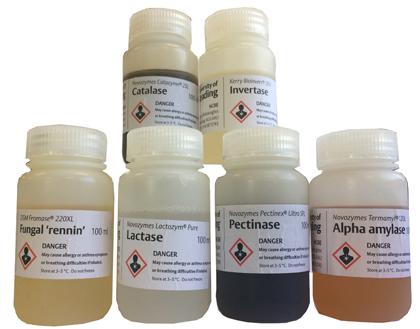Enzymes: For Educational Use

The NCBE supplies a range of high-quality enzymes for use in education. These come from two of the world’s leading enzyme producers: Novozymes of Denmark and DSM of the Netherlands.
If you require these products for uses other than education or research, such as commercial use, you should contact the enzyme manufacturers or their distributors.
We cannot supply to home addresses and will only send to educational or research establishments.
Please also note that we cannot supply these enzymes to the USA.
The individual enzyme pages (see links below) have more information about the products, including suggestions for their use in an educational context. For best results use the enzymes within a year of purchase.
GENERAL SAFETY ADVICE
ENZYME PRODUCTS
All enzymes are supplied as liquids in 100 ml volumes. All are £21 per 100 ml bottle (VAT not included).
AMYLOGLUCOSIDASE (AMG)
CARBOHYDRASE MIX (VISCOZYME)
CATALASE (CATAZYME)
CELLULASE (CELLUCLAST)
CHYMOSIN (MAXIREN)
LACTASE (LACTOZYM)
PECTINASE (PECTINEX)
PECTIN ESTERASE (NOVOSHAPE)
PROTEASE (NEUTRASE)
FUNGAL ‘RENNIN’ (FROMASE)
INVERTASE (BIOINVERT)
DETERGENT ENZYME PRODUCTS
AMYLASE (STAINZYME)
LIPASE (LIPEX)
PROTEASE (ALCALASE)
PROTEASE (SAVINASE)
SPECIAL ENZYME PACKS
RELATED ITEM
DNSA REAGENT BASE (NEW LOWER PRICE)
ENZYME NAMES
Enzyme nomenclature is generally a chaotic area, but the International Union of Biochemistry and Molecular Biology (IUBMB) tries to classify enzymes and to give them systematic names that reflect their reactivity. For example, lipases, such as the one in Lipex® are classified as EC 3.1.1.3 with the systematic name ‘triacylglycerol acylhydrolase’ (EC here stands for ‘enzyme commission’). Shorter and less systematic names have gained common acceptance, and these may be listed as synonyms to the systematic names by IUBMB.
Unfortunately, these common names can result in confusion. For example, an α-amylase will hydrolyse α-1,4 glycosidic linkages in amylose and amylopectin, the two components of starch. Starch is therefore broken down to soluble dextrins and oligosaccharides. In addition, there are so-called β-amylases that also hydrolyse the α-1,4 bonds in starch, but the resulting product is β-maltose. Thus there is no direct relationship between the ‘α’ and ‘β’ in the names of the enzymes and the configuration of the glycoside bonds in the substrates they are acting on.
HOW MUCH ENZYME SHOULD I USE?
Enzyme activity
The internationally-recognised unit of enzyme activity is the Katal (abbreviated to kat). It is defined as the enzyme activity which transforms 1 mole of substrate per second under optimal conditions. In practice, few enzyme suppliers use the Katal, preferring instead units that reflect the preferences of their typical customers. For example, bakers are familiar with amylase activity expressed in ‘SKB units’, whereas brewers traditionally refer to amylase activity (which they call diastatic activity) in ‘Degrees Lintner’. To obtain these various measures of enzyme activity, different laboratory assay methods have been used, and unfortunately there is no means of comparing dissimilar tests without conducting practical tests.
After the trade name of the enzyme there is usually a number and a letter. For example: Termamyl® 120 L. The letter ‘L’ indicates that the product is a liquid. The number refers to the activity of the enzyme in a given laboratory assay. However, there is not necessarily any relationship between the declared activity of the product and its activity in a given practical application, because laboratory assays will seldom correspond with the conditions in which the enzyme is normally used.
It is therefore difficult if not impossible to provide precise recommendations regarding the amount of enzyme that should be used. We suggest that preliminary experiments are carried out in which the enzyme concentration is varied. As a crude rule of thumb, the concentration of the enzyme product could be varied from 0.01% up to 1% (w/w) in the solution where the reaction catalysed by the enzyme is ocurring.
Washing detergent enzymes
Alcalase®, Lipex®, Savinase®, Termamyl Ultra® and Stainzyme® are products for use in washing detergent formulations. Typically, one would add up to 2% by mass of these enzymes to a liquid detergent product, then about 8 g of this liquid would be used per litre of water in a typical European wash. These dosages will result in an enzyme protein concentration of between 0.1 and 1 mg per litre in the wash. As the molecular weights of the enzymes vary from approximately 27,000 to about 55,000 grams per mole, it follows that the enzyme concentration during a wash is in the nanomolar range.
More guidance
Additional guidance on using enzymes is given in the document that can be downloaded from the link above on the left: ‘Working with enzymes’ [this is a new (2016) chapter from the Association for Science Education’s ‘Topics in Safety’ publication].

